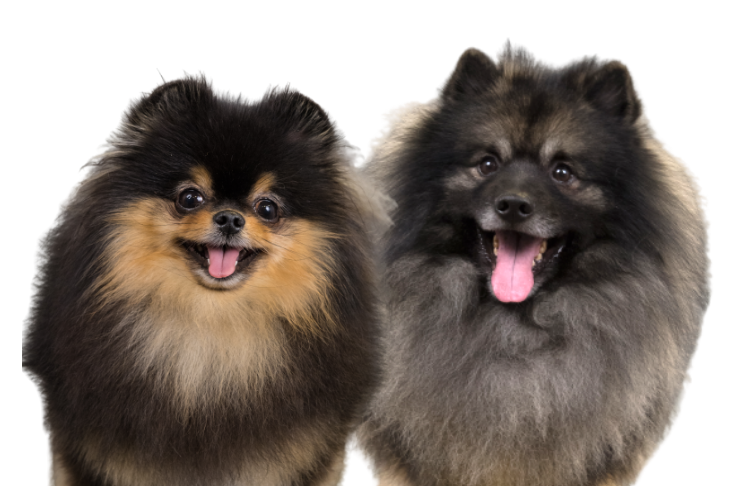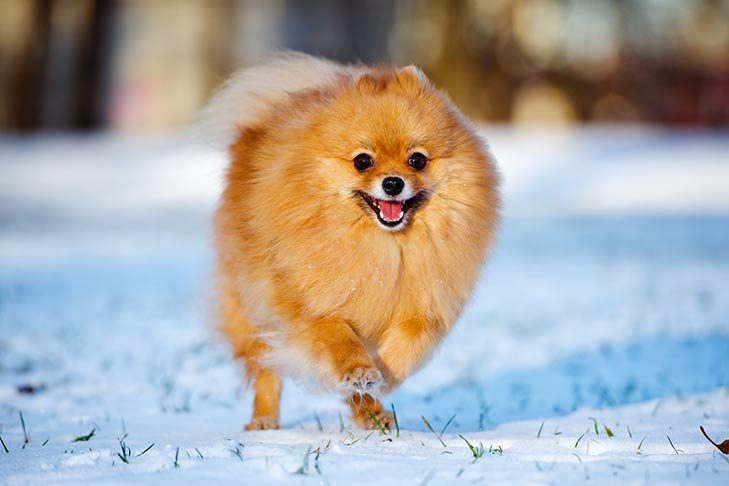
The smiling foxlike face of the Pomeranian is a hallmark of the breed. It makes these bold and adorable dogs irresistible. But there is another breed with an equally sweet foxy face that you might not know as well – the Keeshond (pronounced kayz-hawnd). The Keeshond shares many qualities with the Pomeranian including love of their people, puffy double coats, and high-set plumed tails curling over their backs. Read on to learn more about these lively breeds and how to tell them apart.
Few People Can Identify a Keeshond
After purchasing her first Keeshond in 1972, Brenda Brooks began breeding them two years later. More recently, she began breeding Pomeranians as well. The dogs from her kennel have been quite successful in the show ring, and currently Brooks lives with an impressive pack of Kees and Poms. She says although people can usually identify her Pomeranians, they often struggle to recognize her Keeshonden. “I’ve found that very few people can identify a Keeshond, often misidentifying them as Chow Chows, Siberian Huskies, or Malamutes, among other breeds. Occasionally, someone will ask if a Keeshond is a Pomeranian, but that’s an unusual guess.”
Peter Colcord spent 20 years breeding and showing Keeshonden before he started breeding and showing Pomeranians 7 years ago. He’s bred and finished many champions of both breeds and says although there isn’t much confusion between the two, “Poms come in a variety of colors, one being wolf sable, and as an adult looks very much like a miniature Keeshond.”
- Pomeranian puppy
- Keeshond puppy
Many Traits in Common
The Pomeranian and Keeshond are both spitz breeds and therefore have many physical characteristics in common. For example, they share a square outline and foxy head. Their coats are similar as well with both breeds sporting a soft undercoat with harsh guard hairs that stand away from the body. They also have characteristic feathering on their legs, triangular ears, and a ruff around their neck like a lion’s mane.
According to Brooks, the main differences between the two are their size and color. Keeshonden are measured by height and according to the breed standard males should be 18 inches at the withers and females 17 inches. On the other hand, Pomeranians are measured by weight. The ideal listed in the breed standard is between three and seven pounds, with females tending to be a bit larger than males.
As for color, Kees come in only one acceptable color, the dramatic wolf sable with its gradations of black, gray, and silver. Whereas all colors and patterns are allowed in the Pomeranian. Brooks explains, “Solid colors include red, orange, cream, black, blue, and brown. Non-solid colors include sable, beaver, brindle, and merle. Parti color Pomeranians are any acceptable color plus white. A less common color in Pomeranians is wolf sable, which produces color and markings very similar to those of the Keeshond.”
Colcord believes the biggest difference between the two breeds is in their facial expression. “The Keeshond’s look is largely dependent on their characteristic ‘spectacles,’ which are a combination of markings and shadings around the eyes that must include a delicate dark line slanting from the outer corner of each eye toward the lower corner of each ear.”
- Pomeranian
- Keeshond
Shared Northern History
Pomeranians descended from an exceptionally long line of Arctic working dogs. Their origin can be traced to the regions of Northern Germany and Poland that were once known as Pomerania, giving Poms their name. Although it seems hard to believe, early Poms were not the tiny toy breed we see today. According to Colcord, “Poms were larger in the beginning and were used as sled dogs, guard dogs, and to protect livestock. The smaller ones were frequently kept as companions/pets.”
Keeshonden are also considered an ancient northern breed. Although their precise early role can’t be verified, in the late 1700s, they became the mascot of Holland’s Patriot party. The Patriots were in opposition to the ruling Orangists, and the fallout from their conflict had repercussions for the Keeshond. Brooks says, “When the rebels were crushed by the Orangists, many Keeshonden were destroyed as symbols of the losing party. However, some were hidden and saved on Dutch farms. Their utility on barges as watch dogs and mousers allowed the gradual resurrection of the breed.”
- Keeshond
A Desire for Human Attention
Colcord believes that both breeds are friendly, outgoing, and always interested in the attention of their humans. For him, Poms are inquisitive extroverts that exhibit great intelligence. Plus, they’re always excited to see you and be in your company. He feels their most distinctive characteristic is their happy-go-lucky attitude and their loyalty. “Pomeranians for me are a perfect companion dog. They’re beautiful to look at, they want to be with you all the time, and they’re fun-loving characters that keep you entertained.”
Brooks believes that the average Keeshond owner would define their dog by their overall good nature. The typical Kees is fun loving and affectionate and their nickname “the smiling Dutchman” describes them perfectly. They are outstanding companion dogs and are incredibly adaptable to the lifestyle of their owner. She explains, “Although adult dogs need a moderate amount of physical exercise, the breed excels in all sorts of activities including agility, rally, obedience, lure coursing, sledding, skijoring, herding, and hiking. Keeshonden have become service dogs and emotional support dogs. They are happy to do almost anything, as long as they’re with their people.”
It’s important to note, although both dogs are wonderful family pets, due to their size difference, their ideal home environment is different. An adult Keeshond is sturdy and medium-sized with a special fondness for children. But the Pom, although temperamentally an ideal family dog, is more fragile and easily injured. Brooks advises, “For this breed, jumping off furniture, being stepped on, or getting dropped can lead to serious injury. Consequently, safety is at the forefront of the ideal home for a Pomeranian.”







